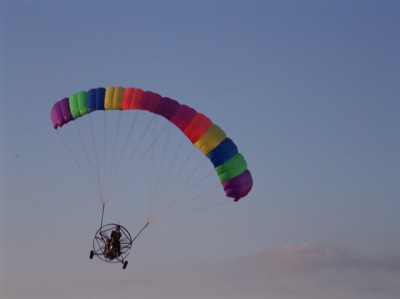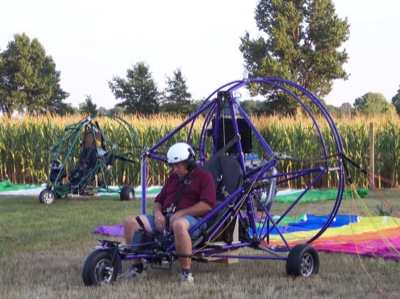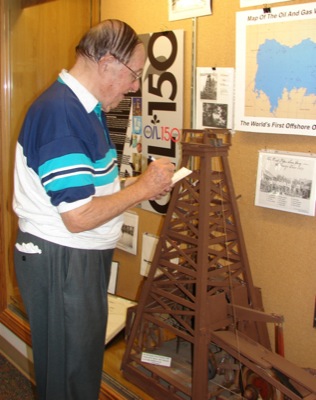Friday, August 28th, 2009
Parachute power
Local enthusiasts of growing sport crave the feeling of flight
By Betty Lawrence

Photo by Betty Lawrence/The Daily Standard
Jeff Everman of Celina takes to the sky in his colorful powered parachute. He can often be seen floating above the city in this magnificent flying machine.
It's a bird, it's a plane, it's a ... powered parachute.
Power parachuting is flying through the air while sitting on a motorized tricycle- or go-kart-looking aircraft that is held up by a very strong parachute. It is touted as one of the fastest growing recreational sports in the U.S., and Mercer County is part of the growing trend.
Area flier Dave Heckman of Minster recently took his 87-year-old grandmother up for a ride on a two-seater, and "she absolutely loved it," he said.
On a recent calm summer evening, Heckman and his wife Ann took to the skies in their powered parachute, also called a PPC, from Jeff Everman's rural Celina airstrip. Everman and his brother, Doug Everman of Celina, also are avid PPC fliers.
The three men have been flying PPCs for a number of years now, and the sight of the flying "go-karts" connected to brightly colored parachutes over Mercer County skies has become almost commonplace.
"I was at a family reunion and a relative talked about their machine and I just had to have one," Doug Everman said. "And I've been flying ever since."
Brother Jeff Everman purchased his PPC soon after, and now they often take to the skies in tandem. Heckman sometimes joins in.
The aircraft, resembling a three-wheeled go-kart with a fan in the back, consists of a framework of aircraft grade steel alloy and aluminum tubes. The 10-by-7-foot aircraft will fit in most garages. It is approximately 6 feet tall, and the folded up parachute is bagged when not in use.
"When we're in the air, people always wave when they see us and when it's on a trailer and we're traveling down the highway, we always get a lot of stares and questions," Jeff Everman said as he put on his helmet and strapped himself into the aircraft.
Prior to take off, the 500-square-foot parachute made of rip stop nylon is spread out behind the aircraft. The 65-horsepower engine that uses regular automobile gasoline in its 10-gallon gas can is started up, and the 62-inch three-blade propeller spins. His airstrip is a 580-by-75-foot strip of flat, mowed grass that aligns a cornfield.
Taxing down the runway on Monday, Jeff Everman's rainbow-colored parachute fully inflates and it was liftoff. Joining him in succession were the equally colorful powered parachutes of Heckman and Doug Everman.
Dancing around in the skies, the three aircraft circled a little and then took off into the wild blue yonder for parts unknown.
"You just have to look out for towers, such as radio and weather towers, and other parachutists if they are up at the same time," Doug Everman said, recalling he will always remember his first flight. "I was in a hurry to get up there and didn't wait on my instructor. It ended up being a very, very bouncy ride."
The best times to fly, the airmen say, are mornings or evenings, when the skies are usually calmer.
"It's so much fun when you're up there, you can't describe the feeling," Jeff Everman said. "You're all alone up there and it's so relaxing."
Because of its design, powered parachutes will fly straight ahead at a cruising speed of around 30 mile per hour. Foot pedal controls (rudders) allow turns whenever the pilot wants. If the pilot increases power, the vehicle climbs and increases altitude; and, if power is decreased, it will gently descend and land. The operator can fly up to 10,000 feet and land on any flat surface.
Even if an engine stalls in flight, the aircraft is steerable and the parachute allows the operator to descend slowly, much slower than that of a sky diver.
Safety features include harness seatbelts, helmets, ear plugs, safety glasses and rearend blinking strobe lights.
"I've been as high as around 7,000 feet, but I usually cruise around 500 to 1,000 feet," Jeff Everman said. "When you get real high, you can't see much and I like to look around."
His wife Kim said she has been up with her husband several times, noting that her husband often just likes to check out his crops and sometimes scares up a deer here and there.
Jeff Everman summed up the growing sport in a few short words, "I like the total solitude of it and the calmness."

Photo by Betty Lawrence/The Daily Standard
Doug Everman of Celina spreads out his 500-square-foot parachute in preparation for a flight. The parachute is connected to his aircraft by strategically located ropes made out of Kevlar.

Photo by Betty Lawrence/The Daily Standard
Jeff Everman dons his helmet and starts up the engine before taxiing down the airstrip behind his home.


